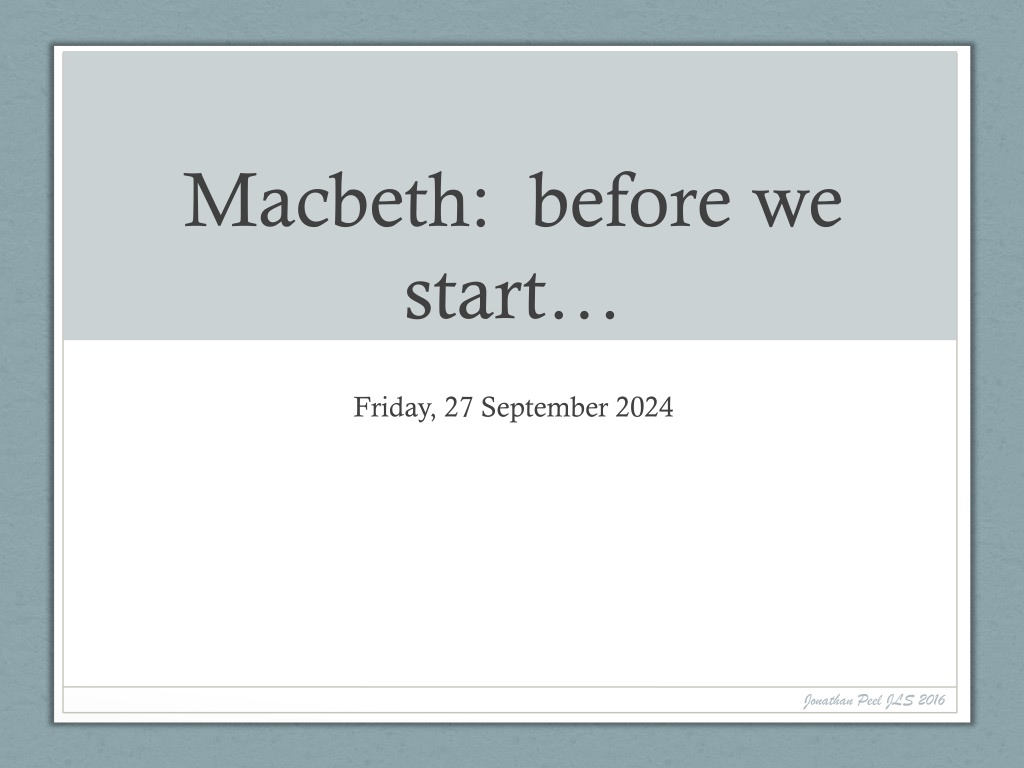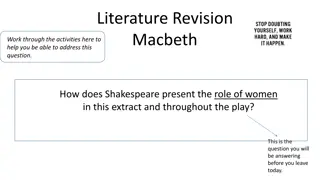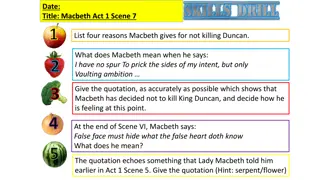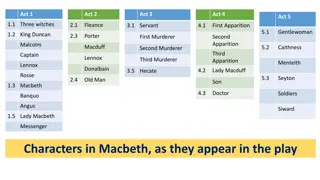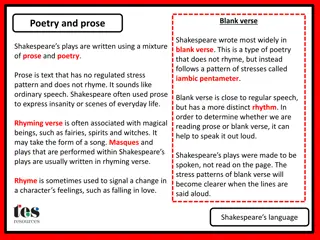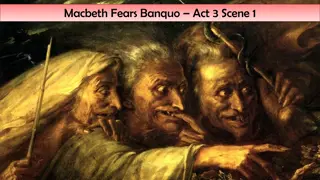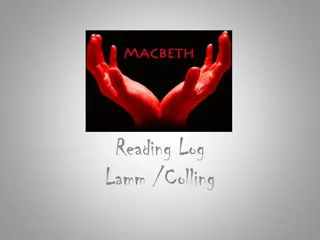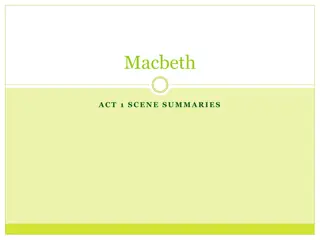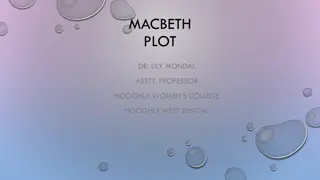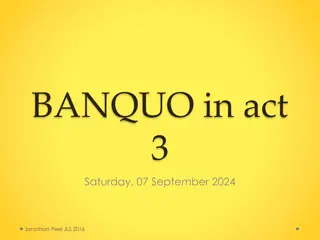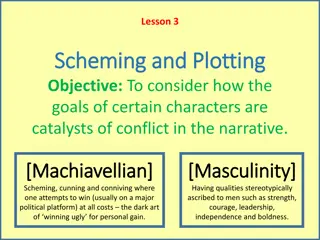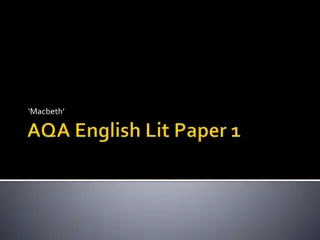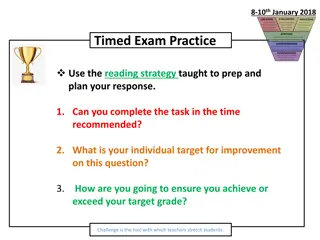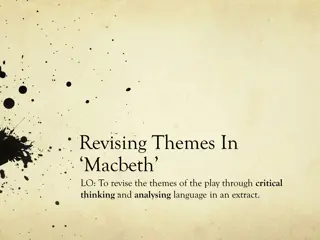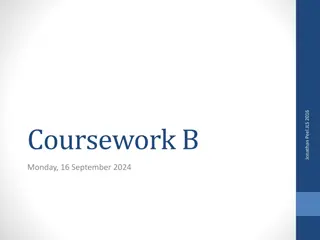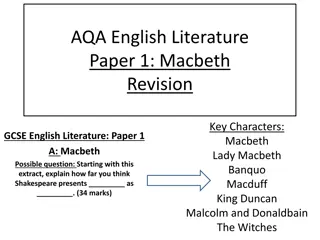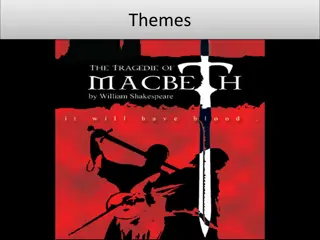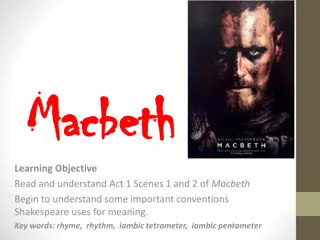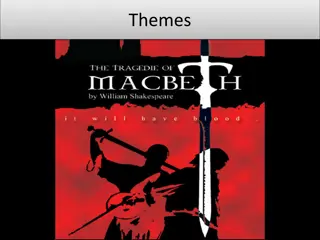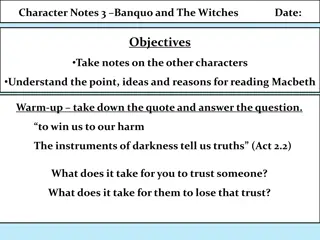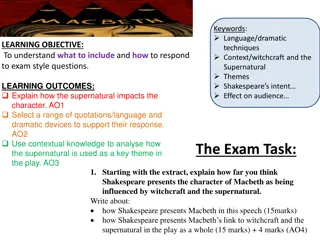Understanding Shakespeare's Verse in Macbeth
Explore the basics of Shakespeare's verse in Macbeth, including the use of iambic pentameter, blank verse, and the variation of verse for different characters and moods. Discover the importance of meter and how it enhances the dramatic effect of the play. Dive into introductory readings and gain insights into the structure and patterns of Shakespearean verse, providing a deeper understanding of Macbeth's language and character development.
Uploaded on Sep 27, 2024 | 0 Views
Download Presentation

Please find below an Image/Link to download the presentation.
The content on the website is provided AS IS for your information and personal use only. It may not be sold, licensed, or shared on other websites without obtaining consent from the author. Download presentation by click this link. If you encounter any issues during the download, it is possible that the publisher has removed the file from their server.
E N D
Presentation Transcript
Macbeth: before we start Friday, 27 September 2024 Jonathan Peel JLS 2016
Other introductory reading My writing can be found here : https://jwpblog.wordpress.com/?s=macbeth Have a browse. There are essays on The Porter, the witches, Macbeth and Lady Macbeth. Don t be put off. Have a read and make some notes Jonathan Peel JLS 2016
Basics of metre. The play is a mixture of VERSE and PROSE Put simply, verse is poetry and prose more the form of writing found in a novel. You can recogonise the verse by its layout it rarely makes a rectangular pattern on the page and lines seem to be of random lengths. This is not the case Jonathan Peel JLS 2016
Shakespeares Verse Is written generally in IAMBIC PENTAMETER. When this does not rhyme, it is called BLANK VERSE . Iambic Pentameter is a Greek term for a simple idea: Each line is made up of a pair of syllables called an IAMB . This is one unstressed and one stressed syllable: de-DUM 5 of these (Penta) make a line of 10 syllables, the basic form of which is Jonathan Peel JLS 2016
THE PINK PANTHER THEME! Actually it is If you hum that well known tune de-dum, de-dum, de-dum de-dum de-dum, you have hummed an iambic pentameter. All you need to do now is to add a line or two from the play to prove it. So foul and fair a day I have not seen u / u / u / u / u / 10 syllables that flow easily off the tongue as Macbeth enters. Each u / unit comprises an IAMB. Jonathan Peel JLS 2016
Variety 3 hours of this would be dull. Shakespeare alters things depending on character and mood. If you think of the IAMB (u/) as a domino, you can imagine how these dominoes can be shuffled or placed for effect. For the witches, he places only 4 dominoes and makes a TETRAMETER: When shall we three meet again? Jonathan Peel JLS 2016
Verse and alteration Verse is conventionally used of high status characters: The King: This castle hath a pleasant seat; the air/ Nimbly and sweetly recommends itself/ Unto our gentle senses We can look a little closer on the next slide, but you might be surprised to learn that verse, with all its rules can be used to very stress and to create effect more easily than prose. Jonathan Peel JLS 2016
Alterations This castle hath a pleasant seat; the air u / u / u / u / u / Nimbly and sweetly recommends itself / u u / u / u / u / Unto our gentle senses u / u / u / u Jonathan Peel JLS 2016
RECAP Iambic Pentameter = 5 x [u\] A trochee = 1 x [\u] A caesura is a break within a line of verse caused by punctuation When writing in verse, Shakespeare will split a line of Iambic Pentameter across 2 or more characters it adds speed and can be used for other effects. Jonathan Peel JLS 2016
GAPS There are few directions in a Shakespeare play Verse can be used to create dramatic pauses If we are used to the rhythm of the Pink Panther, we expect it. The effect of it stopping short can be confusing: Macbeth: Thou canst not say I did it; never shake/ Thy gory locks at me Here in Act 3 when he is horrified by the ghost of Banquo, Macbeth cuts a line short. There is no indented response suggesting a silent de-dum, de-dum during which he sees the ghost and all at the table are confused and shocked. Look for these gaps they can confer a stage effect or cue. Jonathan Peel JLS 2016
Thou and You If you do MFL you are probably familiar with the tu/vous or du/sie issue found in French and German resepctively English in the 17th Century had 2 forms of the 2nd person as well: Thou (singular) and You (plural) Thou is used by adults to children and between close friends. Shifts matter LM uses thy/thou and you to Macbeth in Act 1 BUT once she sees him to be scared she loses Thou and shifts to you for the rest of the play. It is as though she no longer has affection for him and simply uses his formal address as though to a stranger of high status. Similarly when one of high status speaks to an equal, but no friend with thou, this can be perceived as an insult it emphasises status. Jonathan Peel JLS 2016
We are ready Let s begin Shakespeare did not write to be read. Shakespeare did not write for students to study at IGCSE Shakespeare wrote to be performed. I expect to hear you no embarrassed mumbling! You will get out of a text what you put into it. Jonathan Peel JLS 2016
